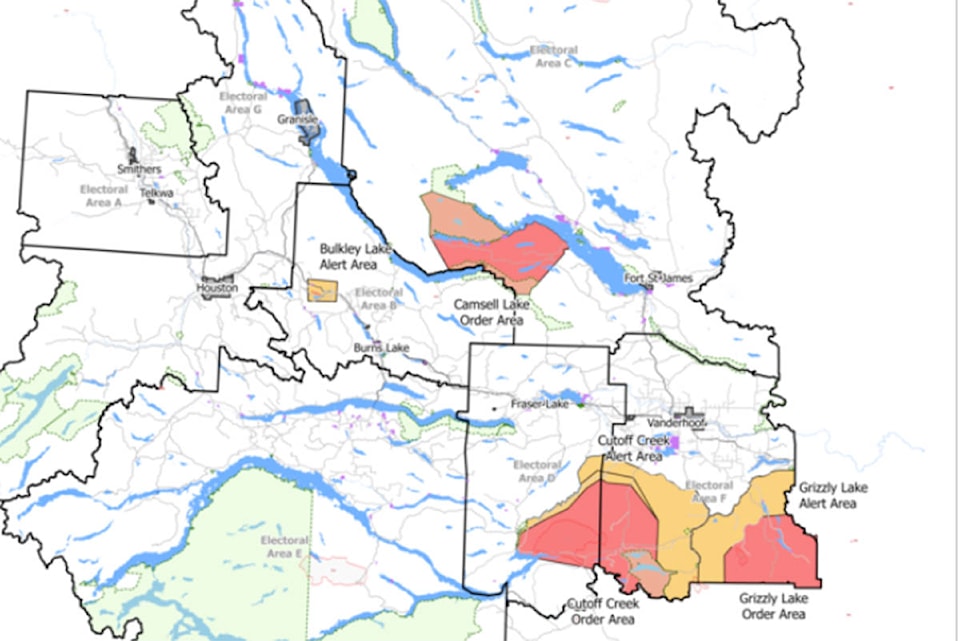The Mayor of Vanderhoof is hoping and praying for rain this weekend as two wildfires near Vanderhoof continue to see growth.
Evacuation orders were issued Wednesday, July 14 by the Regional District of Bulkley Nechako (RDBN) due to the Cutoff Creek and Grizzly Lake fires.
As of July 15, BC Wildfire Service (BCWS) estimated the Cutoff Creek wildfire north of Big Bend Arm at 13,900 hectares, up from 12,000 hectares a day prior.
“The Cutoff Creek Fire, which is southwest of Vanderhoof, grew just over a week quite significantly, and again yesterday the winds came up, and it grew quite a bit,” Thiessen, who is also the chairperson for the regional district, said Thursday afternoon.
He said the blaze appeared to have been moving eastwards towards Kluskus Forest Road, a main artery for industry, including forestry, mining, and ranching.
“There is quite a concern,” Thiessen added. “At this point, the fire is coming quite close to the Kluskus Forest Road, and I know that wildfire management, Saik’uz First Nation and the RCMP are looking very carefully will it be able to remain open for the time being.”
Saik’uz First Nation’s IR Tatuk Lake 7 is included in the evacuation order. Communications officer Sasha Striegler Iannone said while none of their members live within that area, it is of cultural significance to them and home to their culture camp.
Thiessen said another wildfire of concern within the Vanderhoof area is near Grizzly Lake. The out-of-control fire has grown to 4,600 hectares, sparking an evacuation order July 14 for the area southeast of the 900 and 800 Road, including Naltesby Lake and Little Bobtail Lake.
“It’s grown very quickly and very fast, but again though, it’s changed direction, Thiessen said. “Instead of going northeast, it’s going now straight east.”
Any moisture, according to Thiessen, would allow firefighters to get ahead.
An evacuation order remains in place for the Camsell Lake area, near Fort St James, where a wildfire is estimated at 310 hectares.
Thiessen said the 2021 wildfire season came much earlier than previous wildfire seasons.
“In 2018, it started about this time of the year and went for a good month or so after that. This season happened so much sooner and so quickly and with such velocity,” he said.
“It was just unbelievable that we went from a very cool June to almost 40-degree weather, and when you have that, it just changes so quickly.”
With the dry weather, amount of available pine killed forest, and winds that seem to change hastily, Thiessen said now is the time to be cautious and prepared.
Read More: Sparks Lake wildfire near Kamloops remains largest in B.C.
Residents can register to be notified of emergency events through Voyent Alert!.
Thiessen said he and Saik’uz First Nation Chief Priscilla Mueller have spoken to the B.C. Government and asked for more resources.
As temperatures rise and precipitation patterns change due to climate change, Thiessen said he believes it will be the responsibility of each individual to look at where they live and be prepared.
“Certainly we as a municipality, as a regional district, will continue to work with the government trying to find better ways of how can we be prepared, ensure the safety of our people, and the infrastructure that we have in our area, and then for sure our jobs,” he said.
“This fibre that’s burning—it’s not our jobs maybe tomorrow or maybe even in the next few months, but certainly over a long period of time these jobs will disappear, so we need to do everything we can to keep our communities intact and that will be a challenge that we face.”
Hotel availability in smaller communities such as Vanderhoof, where evacuees can register for Emergency Support Services at the Vanderhoof Arena, is limited.
Thiessen said most evacuees are heading to larger centres such as Prince George, where he is thankful for their relationship and how the city has worked with the RDBN.
Do you have a comment about this story? email:
rebecca.dyok@wltribune.com
Like us on Facebook and follow us on Twitter.
